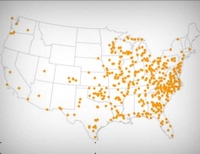Importing Constituents: Incarcerated People and Political Clout in Connecticut
By Peter Wagner and Christian de Ocejo
Prison Policy Initiative
March 25, 2010
Introduction
The Census Bureau counts Connecticut's prisoners as residents of the communities where they are incarcerated, though they can't vote and remain legal residents of the places they lived before they were incarcerated. Crediting thousands of mostly urban and minority men to the wrong communities has staggering implications for our system of representative democracy, which uses the Census to apportion political power on the basis of population.
The Census Bureau counts prisoners as residents of the prison location, but it is only recently that the prison population became large enough to affect legislative districting. As a percentage of population, Connecticut now incarcerates 6 times as many people as it did as recently as 1980.
Moreover, using population as the sole measure of political apportionment in state and local government is also quite new. Counting prisoners as residents of the facility might have made sense in the country's first century, when the mandate of the Census was limited to determining the relative populations of states. But today, state legislatures use the Census to apportion political power within each state.
However, the Census Bureau's prison count violates the law of Connecticut and that of most states, which says that prison is not a residence. A legal residence is the place that people choose to be and do not intend to leave. The statutes are explicit:
No person shall be deemed to have lost his residence in any town by reason of his absence therefrom in any institution maintained by the state. (Sec. 9-14.)
Today, our conception of democracy requires far more detailed and accurate data to reflect where the population -- including people in prison -- actually lives. In almost every respect, except for how it counts people in prison, the Census Bureau's methodology has evolved to keep pace with the changing needs for its data. But now that such a large percentage of the population is incarcerated, where the Census Bureau counts incarcerated people is a question of critical importance.
Redistricting and "One Person, One Vote"
The basic principle of our democracy is that political power should be distributed on the basis of population. Each decade after the census, Connecticut redraws its legislative districts to ensure that each district contains roughly the same population as other districts. When districts are of substantially different sizes, the weight of each vote starts to differ: in underpopulated districts, each vote is worth more, and in overpopulated districts, a vote is worth less. Drawing districts to contain the same number of people ensures that all residents are given the same access to government.
The U.S. Supreme Court first declared that the "One Person, One Vote" principle applied to state legislative redistricting in the landmark case Reynolds v. Sims.[1] The Court struck down an apportionment scheme for the Alabama state legislature that was based on counties and not population. Under Alabama's apportionment plan, sparsely populated Lowndes County had the same number of state senators as densely populated Jefferson County. This gave the residents of Lowndes County 41 times as much political power as the residents of Jefferson County. Reynolds v. Sims barred this practice and put it plainly: "The weight of a citizen's vote cannot be made to depend on where he lives."[2] The Supreme Court ruled that the 14th Amendment's equal protection clause required that districts be drawn to be substantially equal in population.
Substantially equal does not mean exactly equal. The Supreme Court has held, for example, that drawing a district 5% too large, or 5% too small can be acceptable if some other legitimate state interest is served such as avoiding splitting towns between districts.[3]
However in Connecticut, using Census counts of incarcerated people to pad the legislative districts that contain prisons results in a larger variation in population than the Supreme Court has said was acceptable for a legitimate purpose.
In seven Connecticut house districts more than 5% of the population is actually disenfranchised people who are legal residents of other parts of the state. In effect, the commission that drew the legislative districts after the last census said that every group of 85 to 95 people who live near large prisons should be given just as much influence in the capitol building as 100 residents in any other districts.
| District | Legislator | Party | Prison population | Per of district's ideal population that is incarcerated |
|---|---|---|---|---|
| 59 | Jarmoc, Karen | D | 3,353 | 14.9% |
| 90 | Fritz, Mary G. | D | 2,614 | 11.6% |
| 52 | Bacchiochi, Penny | R | 2,291 | 10.2% |
| 37 | Jutila, Ed | D | 2,232 | 9.9% |
| 61 | Conway, Matthew J. | D | 1,529 | 6.8% |
| 139 | Ryan, Kevin | D | 1,466 | 6.5% |
| 93 | Walker, Toni E. | D | 1,289 | 5.7% |
In Connecticut, a State House of Representatives district is supposed to contain 22,553 people, plus or minus 1,127 people, and by Census figures the districts do contain that population. However, a flaw in the Census Bureau's data undermines the state's ability to draw fair districts on the basis of actual population.
The state's prisoners are come from all over the state, but the state's prisons are not evenly distributed, and the people incarcerated there are concentrated in 18 state facilities and one federal facility. The fact that prisoners are disproportionately urban in origin makes the prison miscount even more significant. For example, New Haven and Hartford are each home for 3.6% of the state, but 13.6% and 15.2% of incarcerated people, respectively, come from these two cities.
In 2000, the U.S. Census found 19,331 people in state or federal prison cells in Connecticut. Taken as a group, that population would be almost large enough to constitute a district of their own. Of course, incarcerated people aren't a legislative district. They aren't allowed to vote and are residents of their homes spread throughout the state. But when the legislature credits the prison population to 13 census blocks that contain 18 correctional facilities, they are granting votes cast near prisons more weight than votes cast elsewhere. This is precisely the kind of electoral distortion that the Supreme Court ruled unconstitutional in Reynolds v. Sims.
Recommendations
The Census Bureau's decision to credit thousands of disenfranchised non-residents to the areas with prisons creates serious problems for Connecticut. This problem need not exist in the future, as the state can fix the actual data for redistricting and then lobby the Census Bureau for change in the 2020 Census.
Ideally, the U.S. Census Bureau would change where it counts incarcerated people. They should be counted as residents of their homes, not their prison cells. Unfortunately, there is not enough time before the 2010 Census for this option, but Connecticut can adopt the solution under consideration in Rhode Island, New York, Illinois, Maryland and other states, where the state collects home address information and adjust the federal census data prior to redistricting.
Although states are required to redraw state legislative districts each decade to assure compliance with the federal Constitution's one-person, one-vote requirements, they are not required to use federal Census data in doing so. See Mahan v. Howell, 410 U.S. 315, 330-332 (1973) (rejecting Virginia's argument that it was compelled to use Census Bureau assignments of residences of military personnel in its state legislative redistricting, and suggesting that a state may not use Census data it knows to be incorrect). As the Third Circuit has explained:
Although a state is entitled to the number of representatives in the House of Representatives as determined by the federal census, it is not required to use these census figures as a basis for apportioning its own legislature. Borough of Bethel Park v. Stans, 449 F.2d 575, 583 n.4 (3rd Cir. 1971).
Furthermore:
Neither in Reynolds v. Sims nor in any other decision has this Court suggested that the States are required to include ... persons denied the vote for conviction of crime in the apportionment base by which their legislators are distributed and against which compliance with the Equal Protection Clause is to be measured. The decision to include or exclude any such group involves choices about the nature of representation with which we have been shown no constitutionally founded reason to interfere. Burns v. Richardson, 384 U.S. 73, 92 (1966)
States are therefore free to use their own censuses or to correct how the federal census counts prisoners.
This solution is already employed by the town of Enfield in its town council districts. Enfield modified the census data used for redistricting so that each resident of the town would have the same access to government. Had Enfield based its districts on Census Bureau prison counts, 30% of the third district's population would have been incarcerated, giving every group of 70 residents near the prison as much influence as 100 residents elsewhere in the town.
Democracy requires that "the weight of a citizen's vote cannot be made to depend on where he lives,"[5] including whether he lives near a prison. Unless the state pledges to adjust the Census counts, it will again violate the basic principle of our democracy that representation is to be distributed equally on the basis of population.
Footnotes
1 Reynolds v. Sims, 377 US 533 (1964).
2 Reynolds v. Sims, 377 US 533, 567 (1964).
3 White v. Regester 412 U.S. 755 (1973).
4 See Caroline Porter, "State Prisons Create Uneven Districts," Cheshire Record-Journal, November 8, 2005 (noting issuance of absentee ballots to eligible incarcerated persons in Cheshire).
5 Reynolds v. Sims, 377 US 533, 567 (1964).
Appendix: all districts with state and federal prisons
| District | Legislator | Party | Prison population | Per of district's ideal population that is incarcerated |
|---|---|---|---|---|
| 59 | Jarmoc, Karen | D | 3,353 | 14.9% |
| 90 | Fritz, Mary G. | D | 2,614 | 11.6% |
| 52 | Bacchiochi, Penny | R | 2,291 | 10.2% |
| 37 | Jutila, Ed | D | 2,232 | 9.9% |
| 61 | Conway, Matthew J. | D | 1,529 | 6.8% |
| 139 | Ryan, Kevin | D | 1,466 | 6.5% |
| 93 | Walker, Toni E. | D | 1,289 | 5.7% |
| 109 | Taborsak, Joseph J. | D | 1,212 | 5.4% |
| 5 | Kirkley-Bey, Marie Lopez | D | 901 | 4.0% |
| 129 | Grogins, Auden | D | 796 | 3.5% |
| 106 | Lyddy, Christopher | D | 694 | 3.1% |
| 50 | Alberts, Mike | R | 483 | 2.1% |
| 54 | Merrill, Denise W. | D | 471 | 2.1% |
Events
- April 15-17, 2025:
Sarah Staudt, our Director of Policy and Advocacy, will be attending the MacArthur Safety and Justice Challenge Network Meeting from April 15-17 in Chicago. Drop her a line if you’d like to meet up!
Not near you?
Invite us to your city, college or organization.



